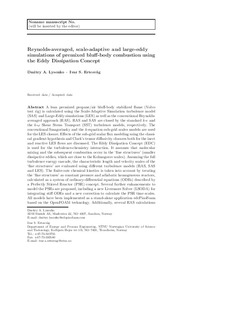| dc.contributor.author | Lysenko, Dmitry | |
| dc.contributor.author | Ertesvåg, Ivar Ståle | |
| dc.date.accessioned | 2018-07-09T07:18:23Z | |
| dc.date.available | 2018-07-09T07:18:23Z | |
| dc.date.created | 2018-02-13T16:02:18Z | |
| dc.date.issued | 2018 | |
| dc.identifier.citation | Flow Turbulence and Combustion. 2018, 100 (3), 721-768. | nb_NO |
| dc.identifier.issn | 1386-6184 | |
| dc.identifier.uri | http://hdl.handle.net/11250/2504725 | |
| dc.description.abstract | A lean premixed propane/air bluff-body stabilized flame (Volvo test rig) is calculated using the Scale-Adaptive Simulation turbulence model (SAS) and Large-Eddy simulations (LES) as well as the conventional Reynolds-averaged approach (RAS). RAS and SAS are closed by the standard k-𝜖� and the k-ω Shear Stress Transport (SST) turbulence models, respectively. The conventional Smagorinsky and the k-equation sub-grid scales models are used for the LES closure. Effects of the sub-grid scalar flux modeling using the classical gradient hypothesis and Clark’s tensor diffusivity closures both for the inert and reactive LES flows are discussed. The Eddy Dissipation Concept (EDC) is used for the turbulence-chemistry interaction. It assumes that molecular mixing and the subsequent combustion occur in the ’fine structures’ (smaller dissipative eddies, which are close to the Kolmogorov scales). Assuming the full turbulence energy cascade, the characteristic length and velocity scales of the ’fine structures’ are evaluated using different turbulence models (RAS, SAS and LES). The finite-rate chemical kinetics is taken into account by treating the ’fine structures’ as constant pressure and adiabatic homogeneous reactors, calculated as a system of ordinary-differential equations (ODEs) described by a Perfectly Stirred Reactor (PSR) concept. Several further enhancements to model the PSRs are proposed, including a new Livermore Solver (LSODA) for integrating stiff ODEs and a new correction to calculate the PSR time scales. All models have been implemented as a stand-alone application \text {edcPisoFoam} based on the OpenFOAM technology. Additionally, several RAS calculations were performed using the Turbulence Flame Speed Closure model in Ansys Fluent to assess effects of the heat losses by modeling the conjugate heat transfer between the bluff-body and the reactive flow. Effects of the turbulence Schmidt number on RAS results are discussed as well. Numerical results are compared with available experimental data. Reasonable consistency between experimental data and numerical results provided by RAS, SAS and LES is observed. In general, there is satisfactory agreement between present LES-EDC simulations, numerical results by other authors and measurements without any major modification to the EDC closure constants, which gives a quite reasonable indication on the adequacy and accuracy of the method and its further application for turbulent premixed combustion simulations. | nb_NO |
| dc.language.iso | eng | nb_NO |
| dc.publisher | Springer Verlag | nb_NO |
| dc.title | Reynolds-averaged, scale-adaptive and large-Eddy simulations of pemixed bluff-body combustion using the Eddy dissipation concept | nb_NO |
| dc.type | Journal article | nb_NO |
| dc.description.version | submittedVersion | nb_NO |
| dc.source.pagenumber | 721-768 | nb_NO |
| dc.source.volume | 100 | nb_NO |
| dc.source.journal | Flow Turbulence and Combustion | nb_NO |
| dc.source.issue | 3 | nb_NO |
| dc.identifier.doi | 10.1007/s10494-017-9880-4 | |
| dc.identifier.cristin | 1564871 | |
| dc.description.localcode | This is a pre-print of an article published in [Flow Turbulence and Combustion]. The final authenticated version is available online at: https://doi.org/10.1007/s10494-017-9880-4 | nb_NO |
| cristin.unitcode | 194,64,25,0 | |
| cristin.unitname | Institutt for energi- og prosessteknikk | |
| cristin.ispublished | true | |
| cristin.fulltext | preprint | |
| cristin.qualitycode | 1 | |
